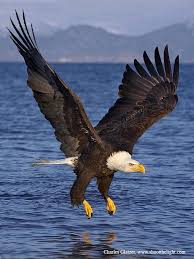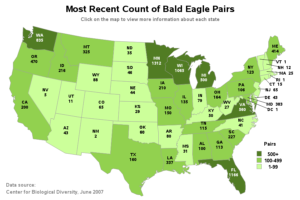The bald eagle holds a special place in the hearts of Americans – despite the scathing criticism of Benjamin Franklin. While he did write that the eagle was a ‘bird of bad moral character,’ and he compared it unfavorably to the turkey, he did not propose the turkey for the US seal. His original proposal was the rattlesnake. His logic being it only attacks when provoked and it never relents once attacked. Other than the short term use of the ‘Don’t Tread on Me’ flag, his efforts did not succeed. The bald eagle not only became the dominant feature of the US seal, it’s also the national bird and animal. Its image can also be found on numerous coins and paper currency.
 Mature adults are easily recognizable by the distinctive white feathers on their heads and tails. The rest of their plumage is dark brown while their beaks, feet, and eyes are bright yellow. Males and females have the same coloration. Adult birds range from 28 to 40 inches long, weigh 6 to 17 pounds, and have wingspans from 6 to 8 feet. Two factors contribute to the these large variances. The first is Bergmann’s rule which states the further an animal population is from the equator, the larger the average size of the animal. Second, bald eagles exhibit sexual dimorphism. Specifically, the females are generally 25% larger than the males. Thus female eagles from Alaska will be near the top of the size range and males from Mexico closer to the bottom.
Mature adults are easily recognizable by the distinctive white feathers on their heads and tails. The rest of their plumage is dark brown while their beaks, feet, and eyes are bright yellow. Males and females have the same coloration. Adult birds range from 28 to 40 inches long, weigh 6 to 17 pounds, and have wingspans from 6 to 8 feet. Two factors contribute to the these large variances. The first is Bergmann’s rule which states the further an animal population is from the equator, the larger the average size of the animal. Second, bald eagles exhibit sexual dimorphism. Specifically, the females are generally 25% larger than the males. Thus female eagles from Alaska will be near the top of the size range and males from Mexico closer to the bottom.
Trouble for the Bald Eagle
Biologists estimate that at the founding of the country there were as many as 500,000 eagles in North America. Their natural habitat stretches from the arctic to Mexico and includes every state except Hawaii. By the mid-twentieth century hunting and the liberal use of the pesticide DDT combined to devastate bald eagle populations. Washed into the natural water system as runoff DDT accumulated in the fatty tissue of fish. While not averse to eating carrion or stealing a meal from smaller predators, fish are the primary food for bald eagles. Sitting at the top of the food chain, the pesticide became even more concentrated in the eagles. Many eagles became sterile, while others produced thin shelled eggs. The weakened eggs couldn’t bear the weight of the incubating parents and cracked before hatching.
The ban of hunting and sales of bald eagles in 1940 stabilized the Alaskan population. The biggest danger was in the lower 48 states. By 1963 the breeding population of bald eagles fell to 417 nesting pairs. In response, the US placed the bald eagle under the protections of the Endangered Species Acts (1966 & 1973). These designations as well as the banning of DDT in 1972, rigorous captive breeding programs and habitat protection were wildly successful. In 1995 the bald eagle was upgraded from endangered to threatened; and in 2007 it was removed the threatened list. At this time there are more than 10,000 nesting pairs of bald eagles in the lower 48 with at least one pair in each state.
Today’s Map
Courtesy of Center for Biological Diversity, our map shows the number of pairs in each state when the eagle was removed from the lists.


